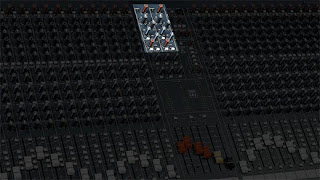
Aux channels are commonly found in the analog world; aux tracks in the world of the DAW. What do they have in common, and how do they differ? What can you do with them?
Let's start in the analog world, specifically in the analog mixing console, which is where many of our modern concepts of DAW mixing originate.
Analog auxiliary channels
An analog mixing console possesses a number of channels. You could, for instance, connect a number of microphones to the same number of channels, and mix a band playing live directly into stereo. Or you could connect the tracks of a multitrack recorder and mix to stereo.
Each channel will have a preamplifier, EQ, auxiliary sends (an explanation for which I will save for another article), pan, fader, solo and mute controls.
A small mixing console might have eight channels; a large console might have thirty-two or more (often in multiples of eight).
Auxiliary channels are exactly like channels, but with fewer features. Typically an aux channel will have a line input (no mic), pan, rotary fader, solo and mute. There may be a couple of aux sends but there will be no (or minimal) EQ.
Although aux channels don't have as many facilities as standard channels, they take up less space on the surface of the console. So they are easily provided as useful extra channels that you can use when you don't need the full features of a standard channel - reverb returns for instance.
Digital mixing consoles can have auxiliary channels too.
Auxiliary channels are sometimes called 'auxiliary returns', but this implies that there has to be a send-return relationship of some kind. Often this is so, but it doesn't have to be.
Auxiliary tracks in the DAW
We tend not to use the word 'channel' so much with reference to the computer digital audio workstation. We talk of 'tracks' instead. In the analog world, a track is something possessed by a recorder, never by a mixing console.
If you look at the edit screen of your DAW, then you will see the tracks clearly. If you look at the mixing screen then you will see a close resemblance to the channels of an analog mixing console. But in the DAW we usually call them tracks. To old-timers it is a little uncomfortable to talk of 'aux tracks' and 'master tracks', but since they are normally represented in time on the edit screen, along with the recorded tracks, it does make a certain amount of sense.
In the DAW, an auxiliary track is a track that doesn't have any recorded audio associated with it. All the other tracks will have audio on them. You cannot record onto an aux track.
What you can do with an aux track is insert a reverb plug-in. You can insert any plug-in you like, but reverb is the most commonly used. You can use the aux sends of the audio tracks to send signals to the reverb, then add that reverb to the stereo mix through the aux track.
In a DAW, an aux track is as fully-featured as any other track. The only difference is that it can't record.
Subgrouping
One good use (among many) for aux channels and aux tracks is subgrouping.
For instance, you might have recorded a band and used eight tracks for the drums. It makes sense to mix those eight drum tracks into stereo, then send them to a stereo aux track so that you can control the level of the entire drum set on just one fader.
(On an analog console you may not have a stereo aux channel, but you could just as easily use two mono aux channels.)
If you have any questions about aux tracks that still need answering, click on the 'Ask a Question' link at the top of the page.
Publication date: Tuesday January 10, 2012Author: David Mellor
No comments:
Post a Comment